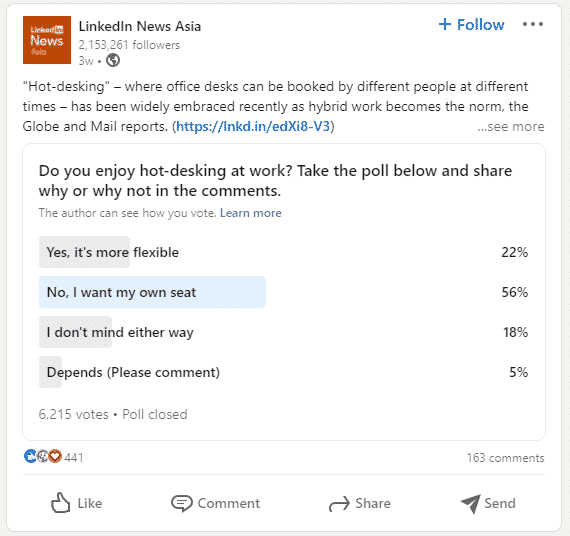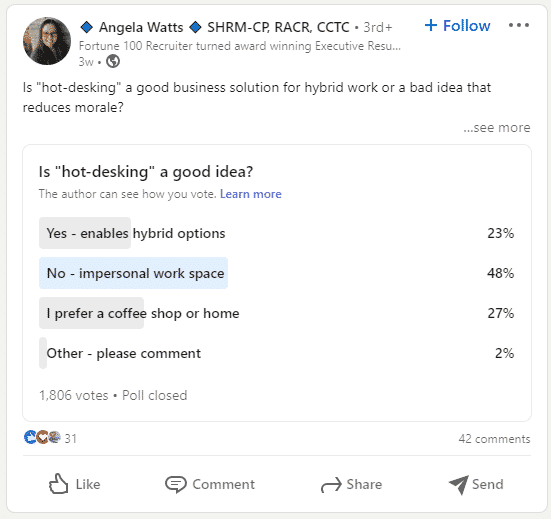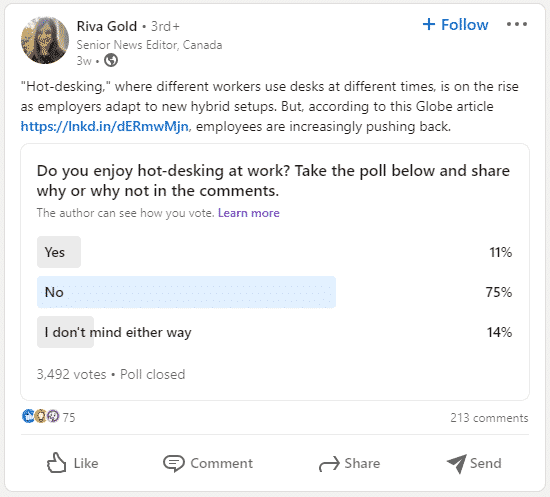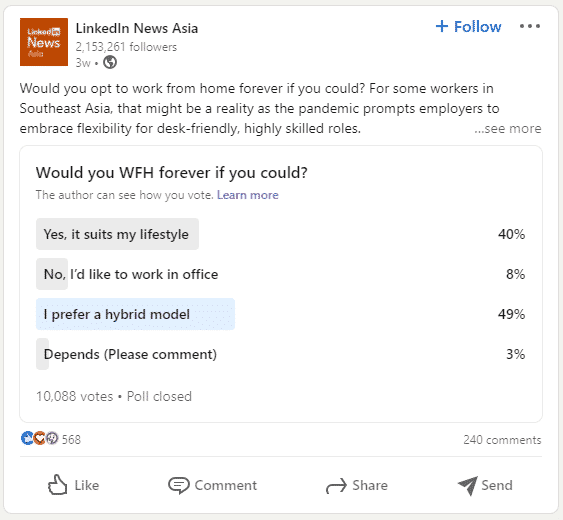The other day I was scrolling through LinkedIn when I came across a few polls about hybrid working. More specifically, they asked how people felt about hot-desking. To my surprise, the resounding answer was that people don’t like it! Before you jump at me saying, ‘hot-desking isn’t the same as hybrid working!’ I know, I know! However, hot-desking enables organisations to implement more flexible work arrangements, enabling hybrid working. Anyway, people who come to the office and pre-book space are effectively hot-desking too!
But these polls got me thinking, is hybrid working what employees really want?



Why employees and businesses want hybrid working
If you were to look on Google and LinkedIn, most articles or posts would favour hybrid, and why shouldn’t they? From a business standpoint, hybrid working would enable you to shrink your real estate footprint, one of the most costly parts of any business, and improve employee retention rate. In addition, the employees gain freedom over how and when they work, greater work-life balance and improved productivity. All of which would have factored into global brands like Microsoft, Spotify, and Apple’s decision to adopt hybrid working styles.
However, you have to take the rough with the smooth. For example, hybrid working can limit people’s ability to communicate and share knowledge since organic interactions are hard to replicate over teams or zoom. In addition, there is the ‘always on’ mentality as the working day no longer stops at 5 pm. Everybody is an email away, making switching off hard to master.
I’m not going to get into every plus and minus of agile working, but if you’d like to know more, check out our Complete Guide to Agile Working.
What is the research saying?
There is a wealth of information about hybrid working out there, especially in the wake of the COVID-19 pandemic. However, I looked for statistics from sources that appeared the most credible and had the largest number of responses.
Here’s what they say:
- Over 2 in 5 employers will adopt hybrid working by 2023
- Predictions estimate 23% of employees will be full-time remote by 2023
- 73% of more than 30,000 workers want flexible work options
- 83% of 9000 respondents said hybrid working would be optimal
- 54.1% of respondents wanted to work from home 3 to 5 days a week
- Only 20% of employees said they would never want to work from home
Seems pretty positive from those statistics, so why are the LinkedIn polls so negative?
What could be causing the negative responses?
Don't Like Change
One of the consistent points in these polls was that hot desks are impersonal, and people want their own seats. It’s worth bearing in mind that this isn’t a handful of people saying this, as these polls collectively had over 10,000 responses! Humans are habitual creatures, so we don’t do well with change. If you don’t believe me, look at the backlash Coca-Cola received when they tweaked their 100-year-old recipe! Don’t forget that working 9-5 has been standard practice since 1938, so operating outside of that can be uncomfortable for some.
You Can't Have Your Cake And Eat It
You may have noticed that we’ve got quite conflicting opinions going on here. Firstly, we have evidence suggesting most people want flexible working options. But, on the other hand, we’ve got poll’s telling us people don’t want flexible seating arrangements. So perhaps this is a simple case of people enjoying the best of both worlds? Especially since employees would quit their job if their employer removed hybrid options! I think there is a compelling argument that this is the case. However, hybrid and fixed desks are incompatible. You can’t be a flexible employee with a fixed location; it’s just not sustainable for businesses.
Don’t believe me? look at the result of a poll that LinkedIn News Asia did a few days after the hot-desking poll!

Negativity Bias
Another possible reason is the phenomenon of negativity bias. Essentially, humans are more likely to pay attention to adverse events than good ones. In addition, we tend to experience negative events more intensely than equally positive ones. Therefore, it could be that the people who disliked flexible seating options had a couple of bad experiences that cancel out all the positives that come with hybrid working. Put yourself in their shoes; you commute to the office, look for a desk, and the only desks available are near busy walkways, toilets or even directly under the AC unit. When you think of it like that, it’s easy to see why some people believe hot-desking isn’t that great.
Not Implementing Hybrid Working Properly
If you’re going to provide flexible working opportunities, you better do it right! If not, employees aren’t likely to receive the full benefits that hybrid working offers. Therefore, I think it’s expected that those who aren’t entirely sold on flexible working aren’t working for a fully hybrid organisation. Data from People Management and TravelPerk illustrate this, with 58% saying they weren’t happy with their current work arrangement, and 63% claiming their company had not made any modifications to their offices to accommodate hybrid working.
Employees Don't Have The Tools To Succeed
Telling employees to work from home a few days a week may seem like a good thing, but often no thought is put into “do my employees have everything they need to work effectively”. We have access to business printers, high-speed wifi, proper office chairs, and even desks when we’re in the office. Well, at home you aren’t going to have that. In fact, 13% of people cite lacking the proper equipment as their main issue with hybrid working. Furthermore, a third of employees report poor internet service prevents them from working effectively from home. Equipment is one problem, but what about space? A study by Stanford University found that 26.3% of homeworkers were working in their bedroom during the COVID-19 pandemic. A further 24.4% were working in a shared room. These aren’t exactly the optimal environments to get your best work done!
Conclusion
Hybrid working offers a lot of positives, but like anything, it also has its drawbacks. However, data points to hybrid working as the preferred mode of working for employees from now on. But, hybrid working is not for everyone or every business. No two companies are the same. They have different people, different processes and different values. One of the most damaging statistics I came across was only 15% of employees had been consulted on their preferred way of working. That’s what I think is the real issue. Organisations aren’t putting the employees at the forefront of decisions that ultimately affect them.






